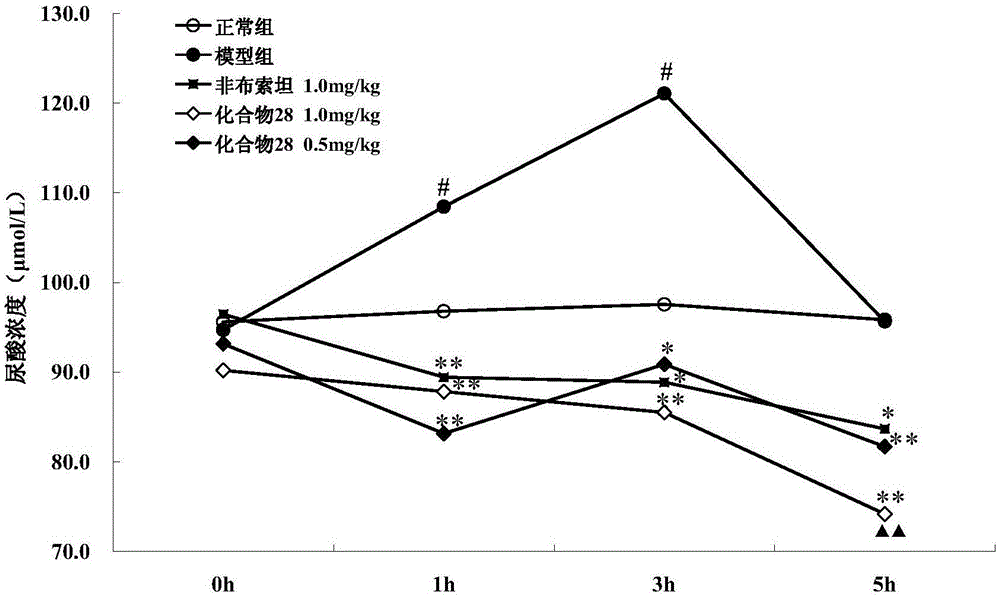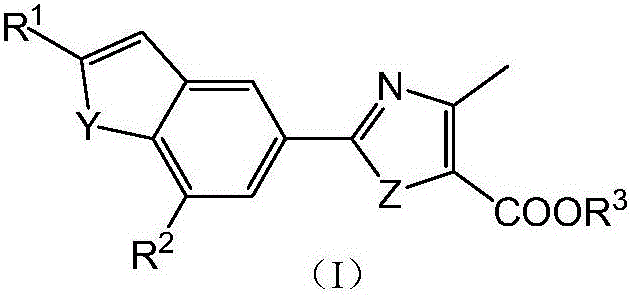Xanthine oxidase inhibitor and application thereof
A compound, alkoxy technology, applied in the direction of anti-inflammatory agents, organic chemistry, non-central analgesics, etc., can solve problems such as large toxic and side effects
- Summary
- Abstract
- Description
- Claims
- Application Information
AI Technical Summary
Problems solved by technology
Method used
Image
Examples
Embodiment 1
[0082] Example 1: Synthesis of 2-(7-cyano-2-ethylbenzofuran-5-yl)-4-methylthiazole-5-carboxylic acid (9)
[0083]
[0084] Step A: Methyl p-hydroxybenzoate (13.7g, 90.0mmol) was dissolved in methanesulfonic acid (150mL), and hexamethylenetetramine (HMTA) (25.2g, 180mmol) was added, and the resulting mixture was heated at 100°C under nitrogen Stir overnight. Cool to room temperature, add concentrated hydrochloric acid (24 mL) and water (300 mL), and stir at room temperature for 30 minutes. Extracted with ethyl acetate (100 mL×2), dried over anhydrous sodium sulfate. The solvent was evaporated under reduced pressure, and the product was purified by column chromatography (200-300 mesh silica gel, ethyl acetate: petroleum ether = 1:20 elution) to obtain methyl 3-formyl-4-hydroxybenzoate (1) ( 4.0g). The yield is 24.7%.
[0085] Step B: Add NBS (3.95g, 22.2mmol) in DMF (40mL) solution dropwise to Compound 1 (4.0g, 22.2mmol) in DMF (60mL) solution in about 40 minutes under ic...
Embodiment 2
[0093] Example 2: Synthesis of 2-(7-bromo-2-ethylbenzofuran-5-yl)-4-methylthiazole-5-carboxylic acid (10)
[0094]
[0095] Compound 7 was hydrolyzed according to the method of experimental step I in Example 1, and acidified to obtain 2-(7-bromo-2-ethylbenzofuran-5-yl)-4-methylthiazole-5-carboxylic acid (10) . 1 H NMR (DMSO-d 6 , 300MHz) δ8.17(s, 1H), 8.02(s, 1H), 6.82(s, 1H), 2.86(q, J=7.2Hz, 2H), 2.67(s, 3H), 1.29(t, J = 7.2Hz, 3H). MS (EI, m / z): 366.0 [M-H] - .
Embodiment 3
[0096] Example 3: Synthesis of 2-(7-cyano-2-isopropylbenzofuran-5-yl)-4-methylthiazole-5-carboxylic acid (18)
[0097]
[0098] Step A: Methyl p-hydroxybenzoate (10 g, 65.7 mmol), sodium acetate hydrate (18.78 g, 138 mmol) and iodine (35 g, 137.9 mmol) were added to methanol (150 mL), and the resulting mixture was stirred at reflux for 1.5 hours. A solution of sodium hydroxide (5.52 g, 138 mmol) in water (200 mL) was added, followed by reflux for 2.5 hours. Cool to room temperature, add dilute sodium bisulfite solution until the color fades. After filtering, the filter cake was washed with a small amount of water, then dissolved with ethyl acetate (200 mL), and dried over anhydrous sodium sulfate. The solvent was distilled off under reduced pressure, and the obtained product was recrystallized from petroleum ether / ethyl acetate to obtain methyl 4-hydroxy-3,5-diiodobenzoate (11) (23g). The yield was 86.7%. 1 H NMR (DMSO-d 6 , 500MHz) δ10.44 (s, 1H), 8.23 (s, 2H), 3.81 ...
PUM
 Login to View More
Login to View More Abstract
Description
Claims
Application Information
 Login to View More
Login to View More - R&D
- Intellectual Property
- Life Sciences
- Materials
- Tech Scout
- Unparalleled Data Quality
- Higher Quality Content
- 60% Fewer Hallucinations
Browse by: Latest US Patents, China's latest patents, Technical Efficacy Thesaurus, Application Domain, Technology Topic, Popular Technical Reports.
© 2025 PatSnap. All rights reserved.Legal|Privacy policy|Modern Slavery Act Transparency Statement|Sitemap|About US| Contact US: help@patsnap.com



